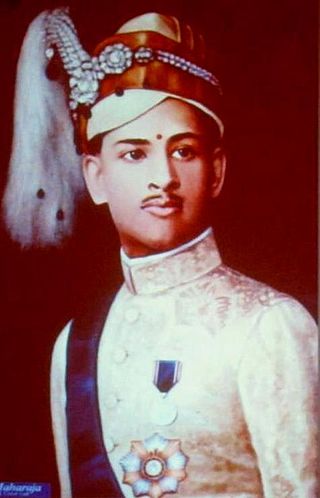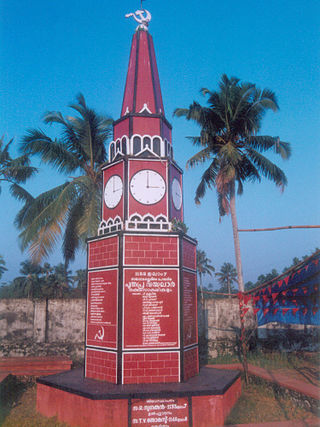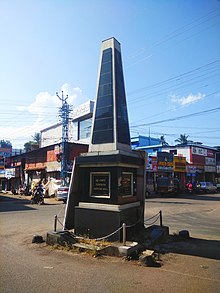
The Kingdom of Travancore, also known as the Kingdom of Thiruvithamkoor or later as Travancore State, was an Indian kingdom that lasted from c. 1729 until 1949. It was ruled by the Travancore Royal Family from Padmanabhapuram, and later Thiruvananthapuram. At its zenith, the kingdom covered most of the south of modern-day Kerala and the southernmost part of modern-day Tamil Nadu with the Thachudaya Kaimal's enclave of Irinjalakuda Koodalmanikyam temple in the neighbouring Kingdom of Cochin. However Tangasseri area of Kollam city and Anchuthengu near Attingal in Thiruvananthapuram were parts of British India.

Sree Padmanabhadasa Sree Chithira Thirunal Balarama Varma, popularly known as Sree Chithira Thirunal, was the last ruling Maharaja of the Indian princely state of Travancore, in southern India until 1949 and later the Titular Maharajah of Travancore until 1991. His reign is known for several notable reforms that have indelible impact on the society and culture of Kerala.

Mannathu Padmanabhan was an Indian social reformer and freedom fighter from the south-western state of Kerala. He is recognised as the founder of the Nair Service Society (NSS), which represents the Nair community that constitutes 15.5% of the population of the state. His birthday is observed as Mannam Jayanti every year. Padmanabhan is considered a visionary reformer who organised the Nair community under the NSS.

Kerala Varma Valiya Koil Thampuran ; 19 February 1845 – 22 September 1914) also spelt Kerala Varma Valiya Koilthampuran and known as Kerala Varma, was a Malayalam - language poet and translator who had an equal facility in writing in English and Sanskrit from the Indian state of Kerala. He was a prince of Parappanad, and consort to the Senior Rani of Attingal and Maharani of Travancore, Bharani Thirunal Lakshmi Bayi, intended to father future sovereigns of Travancore, although the couple was childless, necessitating the adoption of Lakshmi Bayi's grand-nieces. Kerala Varma is also known as the Kalidasa of Kerala, and was both brother-in-law and cousin to painter Raja Ravi Varma, also a prince of Parappanad, though from the Kilimanoor branch, whom he presented with his first oil paints. A third Parappanad prince, his grammarian nephew A. R. Raja Raja Varma, is known as the Panini of Kerala.

Govindan Parameswaran Pillai, also known as Barrister G. P. Pillai, was a freedom fighter, social reformer, barrister, journalist, and publisher. He established the first English language newspaper in South India, The Madras Standard. He drafted the Malayali Memorial in 1891. Pillai is the only Malayali whom Mahatma Gandhi has mentioned in his autobiography. He regularly wrote columns in various newspapers. Pillai stood against autocratic governance in Travancore and promoted civil rights and equal opportunity among all classes.

Kottayam is a city in the Kottayam district of Kerala, India. It is the district headquarters of the district and is located about 151 km (93.8 mi) north of the state capital Thiruvananthapuram. As per the 2011 Indian census, Kottayam has a population of 489,615 people, and a population density of 4,533/km2 (11,740/sq mi). The total Kottayam Metropolitan area has a population of 802,419 people, and a population density of 3,647/km2 (9,450/sq mi).

Kadakkal is a historic town located in the eastern part of Kollam district, Kerala. It is 44 km away from both Kollam City and Thiruvananthapuram. State highway 64 passes through the town. Kadakkal is well known for the social revolutionary activities held in the pre-independent period of India.The town is an important business centre and is known for its Trade ,Kadakkal Viplavam Kadakkal Riot Case,Festivals ,Religious unity & spice production. Kadakkal is reachable through Nilamel, and is well connected to nearby villages like Anchal, Kilimanoor, Parippally and Madathara. Kadakkal is one of the place which facilitates the easiest roadway access to the neighbouring state Tamil Nadu & is one of the upcoming Municipality in Kollam district. The town is only 50 km away from Tamil Nadu border, Trivandrum central & Kollam city.
Kilimanoor Chandran is an Indian author, poet, and columnist from Kerala, India.

The Punnapra-Vayalar uprising was a militant communist movement in the Princely State of Travancore, British India against the Prime Minister, C. P. Ramaswami Iyer and the state. The revolt is named after the two places in which it took place; beginning in Punnapra and ending in Vayalar.
Pangode is an Indian village and a Grama Panchayat located in the Trivandrum district in the state of Kerala. The village is known for its participation in the Indian Independence Movement, through the Kallara-Pangode Struggle. It is situated in the foothills of Western Ghats.
Freedom Fighters & Rehabilitation Division, a division of the Ministry of Home Affairs of India, manages the Swathantra Sainik Samman Pension Scheme - a national pension scheme introduced in 1972 for Freedom Fighters and their dependents. The division also handles rehabilitation assistance for refugees and migrants from Pakistan, Sri Lanka and Tibet. However, there was significant resistance to implementing the scheme. For example, it took 24 years of legal fighting for S. M. Shanmugam to finally receive his pension in August 2006.
Swadeshabhimani was a newspaper published in the Kingdom of Travancore, which was banned and confiscated by the Government of Travancore in 1910 due to its criticisms against the government and the Diwan of Travancore, P. Rajagopalachari.
Kallara is a village and a Grama Panchayat in Thiruvananthapuram district in the state of Kerala, India. It is located near Karette, a junction in the MC road.

Āli Musliyār was the leader of Malabar Rebellion, and a freedom fighter. Musliyār was the Imam of Tirurangadi Masjid from 1907 until his eventual execution at Coimbatore Prison for the allegation against him for calling to fight against British rule. He was an active orator of the Khilafat Movement in Malabar region.

Annie Mascarene was an Indian independence activist, politician and lawyer from Thiruvananthapuram, Kerala. She was a member of the Constituent Assembly of India as representative of State of Travancore-Cochin. In 1952, she became the first woman from Kerala to be elected as a Member of Parliament.
The Kadakal Rebellion of 1938 or Kadakkal Revolt was a civil disobedience movement that happened against unfair toll collection in Kadakkal of Kollam district in the course of India's struggle. It is a unique event in the history of the princely state of Travancore. The event which started as a mass movement against excess tax or toll collection by authorities eventually culminated in the formation of a parallel administration named Kummil Pakuthi, perhaps the smallest in the world lasting for a short span of eight days. The event is also known as Kadakkal Riot Case and is recognized as an Indian independence movement by Ministry of Home Affairs (India).

Kannur, formerly known in English as Cannanore, Arabic as Kannanur, and Portuguese as Cananor, is a city and a Municipal Corporation in North Malabar region, state of Kerala, India. It is the largest city in North Malabar, which is the northernmost region of Kerala. It is sometimes identified Kolathunadu, which was ruled by the Kolathiris. In the 12th and 13th centuries there was trade with Persia and Arabia.

K. Kumar (1894–1973) was an Indian orator, reformer and writer of the Indian pre-independence era. He was one of the earliest socio-political leaders to have brought Mahatma Gandhi's message and the spirit of the national movement to the erstwhile Travancore State.
Travancore State Congress also known as the State Congress is a political party which was formed in 1938 to demand responsible governance in the princely state of Travancore.
N. C. Sekhar alias Narayanan Pillai Sekhar Chandrasekharan Pillai was a freedom fighter, political leader, Rajya Sabha member and writer. He was a member of the first Communist group in Kerala. Sekhar was one of the four founding leaders of the Communist Party of India in Kerala who participated in the formation of the Communist League in Thiruvananthapuram in 1931.













